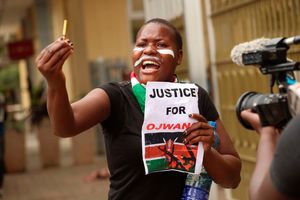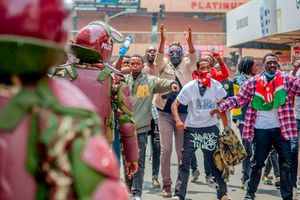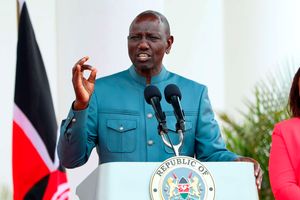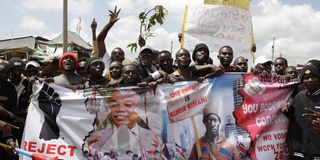
Molo residents protest against the Finance Bill on June 25, 2024.

8am — Gearing up for the unknown
The sun had barely lifted the haze off Kimathi Street when the city centre was already pulsating with tension. We stood in a loose huddle outside Nation Centre, near the entrance, our breaths shallow with anticipation and adrenaline. A security guard glanced at us, then quickly looked away. Unlike the anti-government protests we had religiously covered in the past, the June 25 protests were extraordinary in many ways. There had been a heavy police deployment since 7am, and rumours were already circulating on social media that the protesters intended to invade parliament to stop the 2024 Finance Bill from being passed.
We took turns adjusting and tightening each other's chin straps like soldiers preparing for battle, tugging until the fit was just right. This ritual was mechanical, precise and unsentimental, not out of habit but a necessity for our safety.
The protests had been building for a week. The previous week, the protesters had almost entered parliament. Images of parliamentary staff scampering for safety that day remained etched in our minds. The 2024 Finance Bill, packed with taxes on everyday essentials such as bread, mobile money, vegetable oil and sanitary towels, had angered the youth. Protesters had declared “seven days of rage” through social media platforms, especially TikTok and X, escalating hashtags such as #OccupyParliament into a physical march towards Kenya’s parliament.
But the tension was different here—urgent and electric. The bill had passed its final reading at Parliament, but we were worried by the growing numbers of youths and their increased coordination on digital platforms.
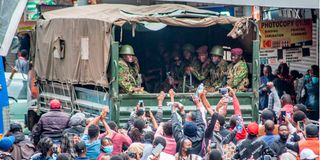
Anti-Finance Bill protesters mob a police lorry during demonstrations on the streets of Nairobi on June 20, 2024.
In the distance, a whistle pierced the city’s ambient hum, followed by the echoing thud of boots. A police vehicle careened across the street, and the handful of protesters who had gathered outside the Nation Centre ran in all directions. It was at this point that we all split up. My colleague Mike Yambo and I joined the coverage of the protesters who were now marching along Kenyatta Avenue, while the other two colleagues joined the coverage of the protests along Tom Mboya Street.
11.30am — Kenyatta Avenue
As the clock ticked toward midday, Kenyatta Avenue was no longer just a street. It was a pressure point — the place where a nation’s grief, fury, and youth collided. Most of the protesters from across different streets had already gathered. And as the crowds grew, the tear gas thickened. Somewhere behind us, water cannons fired again, sweeping indiscriminately across the street. But what I saw stunned me. A section of the protesters endured the tear gas. When the water cannons swayed across the street, I particularly remember a young man who climbed directly on top of the cannon and shouted, “We reject the Finance Bill, we reject”, before he was brought down by a group of police officers and he vanished into the crowd. At this time, some of the protesters were drenched with the pink-stained water from the cannons.
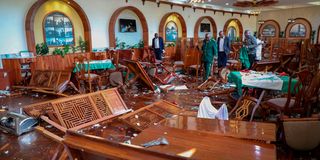
Furniture in the National Assembly's dinning hall that were vandalised by rioters who stormed Parliament Buildings on June 25, 2024.
As a journalist, you’re trained to walk a line — never too close to the protesters, never too deep among the police. That distance is your safety, your clarity. But on this day, that line did not exist. The crowd had closed it. The police had shifted. We didn’t know who to trust. What was left were the safety gears and working and moving together as a team. In the ensuing melee, I lost contact with my colleague Yambo. It was not until in the evening that I learned he had gotten back to the office safely after witnessing one of the protesters who was standing to him being shot by a rubber bullet.
For close to 30 minutes, it was a human tide versus a shrinking wall of shields. By 1pm, the fear of a Parliament invasion was no longer speculative. It was imminent. The protesters kept pushing, chanting, advancing. The police tried to hold the line but the crowd was relentless. Too large. Too loud. Too unified. Some officers fell back. Others simply disappeared, melting into the city they were meant to control.
The gates near the Supreme Court had become the final frontier. There were concrete barricades, water cannons, and a desperate line of anti- riot police trying to hold off thousands. There was a huge standoff.
We retreated to the Holy Family Basilica, which had become an unlikely refuge. It was there that we found a moment of pause. We drank bottled water handed out by volunteers. Journalists, medics, even some of the injured protesters, rested on the shaded steps. Ambulances came and went. One by one, the injured were carried in and treated. The sacred space turned into a triage. But from a distance, we still heard the thud of canisters, the distant roar of a crowd, and the hiss of smoke grenades detonating near Uhuru Highway.
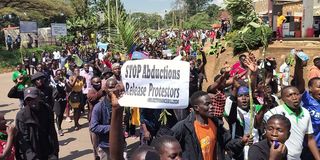
Anti-Finance Bill protesters demonstrate on the streets of Kisii town on June 25, 2024.
1pm — Parliament on the brink
Just a minute before 2pm, the unthinkable unfolded: the barricade at the Supreme Court was breached. The crowd, now beyond restraint, charged through. The anti-riot police scrambled to contain the surge but were quickly overwhelmed. Sensing danger, the police ran for safety. One thing I learned that day: if a police officer with all the tools to protect you is running faster than you, it is a clear sign that you are in danger. Canisters flew over the compound walls and into the Basilica grounds. Everyone scampered in different directions for safety, ducking behind pillars while others took cover in the underground parking at the Basilica.
The police at this point had only one frontier: the parliament road junction and City Hall Highway. For a few minutes, they unsuccessfully tried to block the protesters until they gave in. The protesters flooded through. For close to 20 minutes, Parliament Road was in chaos. Some of the protesters, unarmed and defiant, fell where they stood. Even the police horses began to panic. Some defecated on themselves, trembling beneath the police riders who had lost all sense of control.
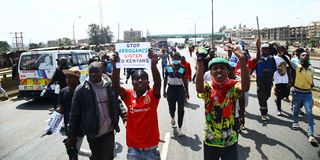
Anti-Finance Bill protesters in Nairobi march to city's CBD on June 25, 2024.
2.30pm — The Bill passes in blood
At 14.20pm, the opposition MPs emerged from Parliament — not in suits of calm, but in defiant solidarity. They walked straight into the chaos, some raising their fists in solidarity with the protesters. They were led by then Minority Leader Opiyo Wandayi. At 2.30pm, amid bullets, blood and tear gas — the Finance Bill was passed.
The sound of gunfire cracked overhead. It wasn’t clear if it was live ammunition or warning shots, but it didn’t matter — it was enough to turn the ground into a battlefield.
With every round fired into the air, the protesters would drop to the ground, hands over their heads, holding their breath. And then — silence. A few of them would rise, inch forward, chanting, waving flags. Another shot — they hit the ground again. It became a kind of cruel choreography, a dance between defiance and death.
We saw at least three youths lying down, lifeless, along Parliament Road. There were at least three of them, maybe more. They were young men, some of whom were still holding Kenyan flags. I had seen some of them just minutes earlier, their faces lit with adrenaline and their voices hoarse from chanting. Now they lay still, their eyes open, dust settling around them like a shroud. We were journalists, yes, but in that moment, we were broken too. We froze. Not as journalists, but as people.
There was a rumour that a journalist had been shot. My heart clenched. I was with my colleague Kevin Cheruiyot, and we both looked at each other, afraid to ask the obvious: Was it one of ours? It turned out to be false. But the fear it planted in us remained.
At one point, we watched as a group of protesters carried the bodies of the fallen, refusing to let ambulances take them. “They will cover it up,” someone yelled. “They’ll take the bodies and erase the truth.” They wanted the country — and the world — to see what had happened here. To bear witness.
I was heartbroken. And I couldn’t write anymore. The updates I had been sending to the newsroom no longer mattered.
4pm — A moment of grace
Amid the chaos, blood, and fear, there were moments that reminded us of our shared humanity. One such moment has stayed with me – protesters escorting MP Jackson Kosgei, who uses a wheelchair. Separated from his security detail in the confusion and panic around Parliament, the MP had been left stranded in the compound. But the young protesters saw him and acted. They cleared a path, gently turned his wheelchair around, and rolled him out of danger, all the way from Parliament Road to safety. No insults. No threats. Just care, protection and dignity.
5pm — Nairobi in ruins
We finally left the Parliament precincts at around 5pm. We walked in silence, each of us trying to process the enormity of what we had just witnessed.
The streets no longer felt like Nairobi. It felt like the aftermath of a war. There was a mixture of smoke and tear gas in the air, as well as something more invisible but heavier: fear. The damage was everywhere along the streets. Glass crunched beneath our boots — shards from shops and kiosks that had been smashed open amid the day's chaos. Businesses had been looted, their shelves emptied and their windows smashed. The City Hall offices were still on fire. The scene at Carrefour along City Hall Way was even worse — wheat flour and other goods were strewn everywhere.
Kenyans who had stayed in their offices all day were now finally leaving. Their hands raised high, on police instruction, to signal they were no threat. The sight was surreal.

